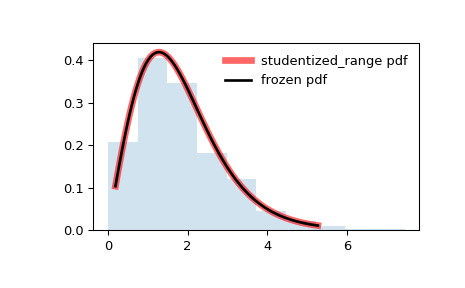本文简要介绍 python 语言中 scipy.stats.studentized_range 的用法。
用法:
scipy.stats.studentized_range = <scipy.stats._continuous_distns.studentized_range_gen object>#学生化范围连续随机变量。
作为
rv_continuous类的实例,studentized_range对象从它继承了一组通用方法(完整列表见下文),并用特定于此特定发行版的详细信息来完成它们。注意:
studentized_range的概率密度函数为:对于 、 和 。
studentized_range将 的k和 的df作为形状参数。当超过100,000时,使用渐近近似(无限自由度)来计算累积分布函数[4]和概率分布函数。
上面的概率密度在“standardized” 表格中定义。要移动和/或缩放分布,请使用
loc和scale参数。具体来说,studentized_range.pdf(x, k, df, loc, scale)等同于studentized_range.pdf(y, k, df) / scale和y = (x - loc) / scale。请注意,移动分布的位置不会使其成为“noncentral” 分布;某些分布的非中心概括可在单独的类中获得。参考:
[1]“Studentized range distribution”,https://en.wikipedia.org/wiki/Studentized_range_distribution
[2]巴蒂斯塔、本·德维德等人。 “外部学生化的正态中频分布。” Ciência e Agrotecnologia,第一卷。 41,没有。 4, 2017, pp. 378-389., doi:10.1590/1413-70542017414047716。
[3]哈特,H.莱昂。 “范围和学生化范围表。”数理统计年鉴,卷。 31,没有。 4,1960,第 1122-1147 页。 JSTOR,www.jstor.org/stable/2237810。 2021 年 2 月 18 日访问。
[4]隆德、R. E. 和 J. R. 隆德。 “算法 AS 190:学生化范围的概率和上分位数。”皇家统计学会杂志。系列 C(应用统计),第一卷。 32,没有。 2,1983 年,第 204-210 页。 JSTOR,www.jstor.org/stable/2347300。 2021 年 2 月 18 日访问。
例子:
>>> import numpy as np >>> from scipy.stats import studentized_range >>> import matplotlib.pyplot as plt >>> fig, ax = plt.subplots(1, 1)计算前四个时刻:
>>> k, df = 3, 10 >>> mean, var, skew, kurt = studentized_range.stats(k, df, moments='mvsk')显示概率密度函数(
pdf):>>> x = np.linspace(studentized_range.ppf(0.01, k, df), ... studentized_range.ppf(0.99, k, df), 100) >>> ax.plot(x, studentized_range.pdf(x, k, df), ... 'r-', lw=5, alpha=0.6, label='studentized_range pdf')或者,可以调用分布对象(作为函数)来固定形状、位置和比例参数。这将返回一个 “frozen” RV 对象,其中包含固定的给定参数。
冻结分布并显示冻结的
pdf:>>> rv = studentized_range(k, df) >>> ax.plot(x, rv.pdf(x), 'k-', lw=2, label='frozen pdf')检查
cdf和ppf的准确性:>>> vals = studentized_range.ppf([0.001, 0.5, 0.999], k, df) >>> np.allclose([0.001, 0.5, 0.999], studentized_range.cdf(vals, k, df)) True与其使用 (
studentized_range.rvs) 生成随机变量,这对于这种分布来说非常慢,我们可以使用插值器来近似逆 CDF,然后使用这个近似逆 CDF 执行逆变换采样。这个分布有一个无限但细的右尾,所以我们将注意力集中在最左边的 99.9% 上。
>>> a, b = studentized_range.ppf([0, .999], k, df) >>> a, b 0, 7.41058083802274>>> from scipy.interpolate import interp1d >>> rng = np.random.default_rng() >>> xs = np.linspace(a, b, 50) >>> cdf = studentized_range.cdf(xs, k, df) # Create an interpolant of the inverse CDF >>> ppf = interp1d(cdf, xs, fill_value='extrapolate') # Perform inverse transform sampling using the interpolant >>> r = ppf(rng.uniform(size=1000))并比较直方图:
>>> ax.hist(r, density=True, histtype='stepfilled', alpha=0.2) >>> ax.legend(loc='best', frameon=False) >>> plt.show()
相关用法
- Python SciPy stats.skewnorm用法及代码示例
- Python SciPy stats.semicircular用法及代码示例
- Python SciPy stats.skellam用法及代码示例
- Python scipy.stats.somersd用法及代码示例
- Python SciPy stats.sem用法及代码示例
- Python SciPy stats.siegelslopes用法及代码示例
- Python SciPy stats.skewcauchy用法及代码示例
- Python SciPy stats.scoreatpercentile用法及代码示例
- Python SciPy stats.skew用法及代码示例
- Python SciPy stats.spearmanr用法及代码示例
- Python SciPy stats.shapiro用法及代码示例
- Python SciPy stats.sigmaclip用法及代码示例
- Python SciPy stats.skewtest用法及代码示例
- Python SciPy stats.special_ortho_group用法及代码示例
- Python SciPy stats.sobol_indices用法及代码示例
- Python SciPy stats.anderson用法及代码示例
- Python SciPy stats.iqr用法及代码示例
- Python SciPy stats.genpareto用法及代码示例
- Python SciPy stats.cosine用法及代码示例
- Python SciPy stats.norminvgauss用法及代码示例
- Python SciPy stats.directional_stats用法及代码示例
- Python SciPy stats.invwishart用法及代码示例
- Python SciPy stats.bartlett用法及代码示例
- Python SciPy stats.levy_stable用法及代码示例
- Python SciPy stats.page_trend_test用法及代码示例
注:本文由纯净天空筛选整理自scipy.org大神的英文原创作品 scipy.stats.studentized_range。非经特殊声明,原始代码版权归原作者所有,本译文未经允许或授权,请勿转载或复制。
